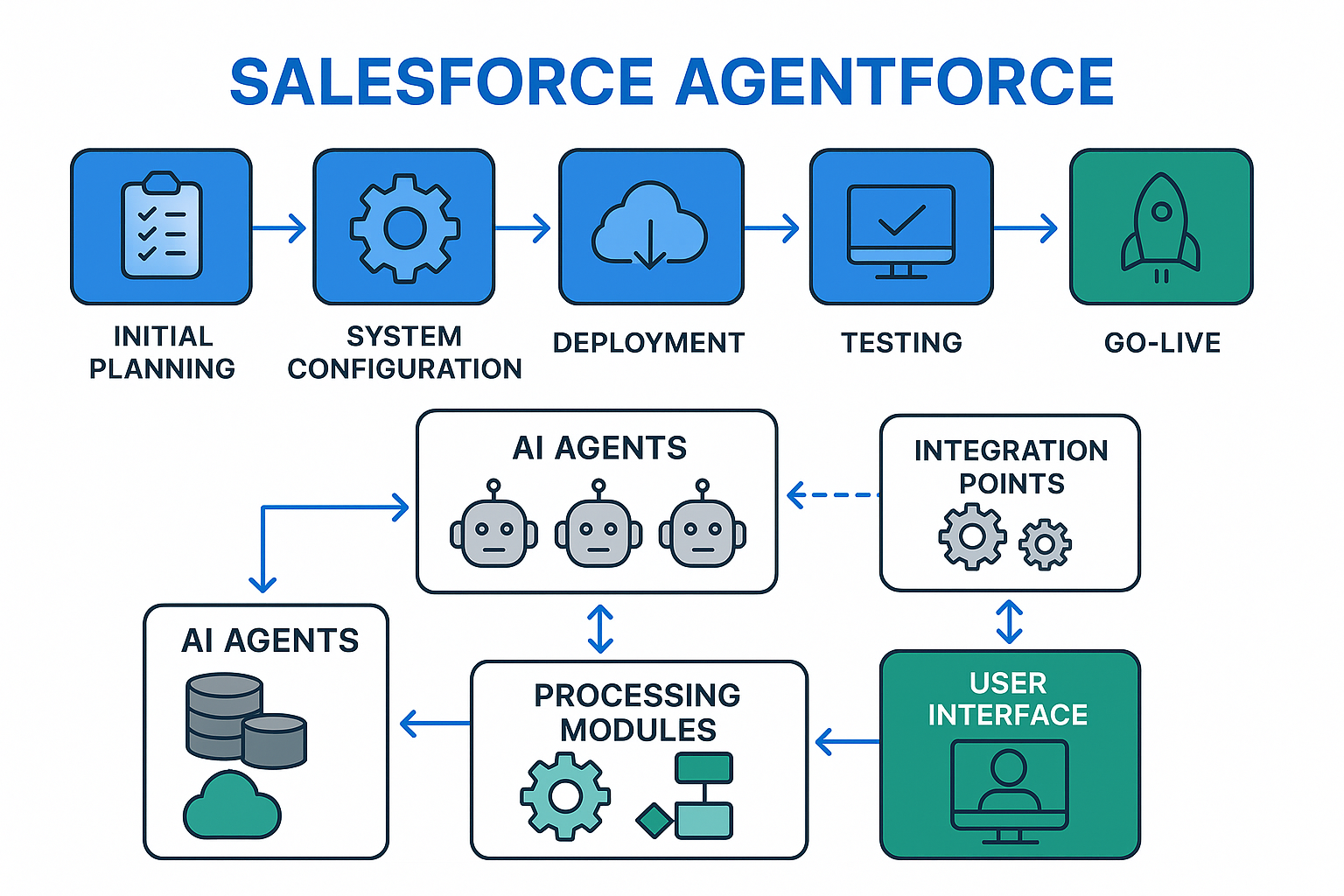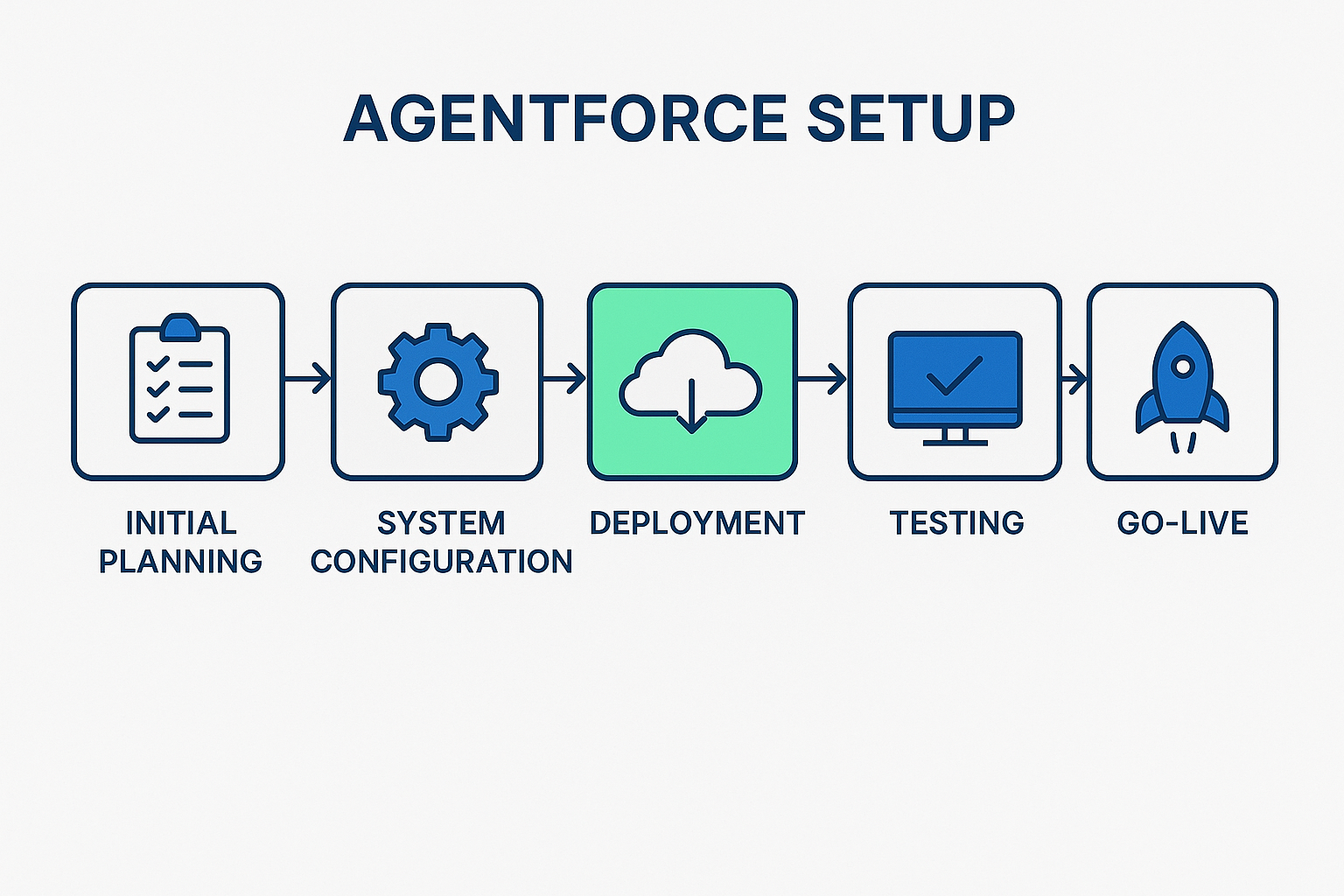Building Your First AI Agent with Salesforce Agentforce: The Complete Developer's Guide for 2025
Last updated: August 3, 2025 | Reading time: 15 minutes
The era of autonomous AI agents has arrived, and Salesforce Agentforce is leading the charge. With 8,000+ customers already signed up and AI agent usage increasing by 233% in just six months, Agentforce represents the most significant advancement in enterprise AI automation since the introduction of CRM itself.
This comprehensive guide will walk you through everything you need to know to build, deploy, and optimize your first AI agent using Salesforce Agentforce in 2025.

What Makes Agentforce Different?
Unlike traditional chatbots or simple AI assistants, Agentforce agents are autonomous. They don't just respond to queries—they proactively analyze data, make decisions, execute actions, and handle complex multi-step workflows without constant human supervision.
Key Differentiators:
- Atlas Reasoning Engine: Breaks down complex requests into actionable steps
- Autonomous Decision Making: Agents can escalate to humans when needed
- Enterprise-Grade Security: Built on Einstein Trust Layer
- No-Code Configuration: Use Agent Builder for visual setup
- Real-Time Learning: Agents improve based on interactions and feedback
The State of Agentforce in 2025
Market Adoption Statistics
- $900M+ AI and Data Cloud revenue generated in Q4 FY25 alone
- 5,000+ deals closed using Agentforce technology
- 100,000+ AI-powered conversations handled daily
- 40% faster lead qualification compared to traditional methods
- 84% case resolution rate without human intervention
Recent Agentforce 3.0 Updates
The latest version includes:
- Command Center: Complete observability for agent management
- 50% lower latency for faster response times
- Model Context Protocol (MCP) support for better interoperability
- 30+ partner integrations including AWS, Google Cloud, IBM, and Stripe
- Support for 6 new languages: French, Italian, German, Spanish, Japanese, Portuguese
Pre-Built Agent Types Available
Salesforce offers several ready-to-deploy agents:
1. Service Agent
- Purpose: 24/7 customer support across all channels
- Capabilities: Query resolution, case routing, knowledge base access
- Setup Time: Under 10 minutes with templates
2. Sales Development Representative (SDR) Agent
- Purpose: Autonomous lead qualification and meeting booking
- Capabilities: Product Q&A, prospect engagement, calendar scheduling
- Channels: Email, WhatsApp, SMS, web chat
3. Sales Coach Agent
- Purpose: Personalized sales training and performance improvement
- Capabilities: Role-play scenarios, negotiation feedback, CRM-based coaching
4. Personal Shopper Agent
- Purpose: E-commerce personalization and purchase assistance
- Capabilities: Product recommendations, search guidance, purchase support
5. Campaign Agent
- Purpose: Marketing automation and optimization
- Capabilities: Campaign brief generation, audience targeting, journey optimization
Step-by-Step Implementation Guide

Phase 1: Prerequisites and Setup (Week 1)
Requirements Checklist:
- [ ] Salesforce Enterprise or Unlimited edition
- [ ] Einstein Trust Layer enabled
- [ ] Data Cloud access (recommended)
- [ ] Admin permissions for Agent Builder
- [ ] Defined use case and success metrics
Initial Configuration:
-
Enable Agentforce in Setup
- Navigate to Setup → AI → Agentforce
- Accept terms and configure security settings
- Set up Einstein Trust Layer if not already enabled
-
Configure Data Sources
- Connect relevant Salesforce objects
- Set up external data connections if needed
- Configure knowledge base articles
Phase 2: Agent Design and Build (Week 2)
Using Agent Builder:
-
Define Agent Purpose
- Create clear job description
- List specific tasks and responsibilities
- Set boundaries and escalation rules
-
Configure Agent Topics
- Use natural language instructions
- Define trigger conditions
- Set up response templates
-
Create Action Library
- Connect Salesforce Flows
- Link to Apex methods
- Integrate MuleSoft APIs
- Add external system calls
Example Agent Configuration:
Agent Name: "Customer Support Pro"
Purpose: "Handle tier-1 customer support inquiries autonomously"
Topics:
- Order Status Inquiries
- Product Information Requests
- Account Access Issues
- Return/Exchange Processes
Actions:
- Query Order Management System
- Update Customer Records
- Create Support Cases
- Send Email Notifications
Phase 3: Testing and Optimization (Week 3)
Testing Framework:
- Unit Testing: Test individual agent responses
- Integration Testing: Verify system connections
- User Acceptance Testing: Get feedback from end users
- Load Testing: Ensure performance under volume
Key Metrics to Monitor:
- Response Accuracy: Percentage of correct responses
- Resolution Rate: Cases closed without escalation
- Response Time: Average time to first response
- User Satisfaction: Feedback scores and ratings
- Escalation Rate: Percentage requiring human intervention
Phase 4: Deployment and Monitoring (Week 4)
Deployment Strategy:
- Soft Launch: Deploy to limited user group
- Monitor Performance: Use Agentforce Command Center
- Gather Feedback: Collect user and stakeholder input
- Iterative Improvement: Refine based on real-world data
- Full Rollout: Deploy to entire organization
Advanced Configuration Techniques
Multi-Agent Orchestration
Configure multiple agents to work together:
Primary Agent: Customer Service Hub
- Routes complex queries to specialized agents
- Manages context across agent handoffs
- Provides unified customer experience
Secondary Agents:
- Technical Support Agent (for technical issues)
- Billing Agent (for payment/invoice queries)
- Product Expert Agent (for feature questions)
Custom Integration Patterns
Apex Integration Example:
@InvocableMethod(label='Process Agent Request')
public static List<String> processAgentRequest(List<AgentRequest> requests) {
List<String> responses = new List<String>();
for(AgentRequest request : requests) {
// Custom business logic
String response = handleCustomLogic(request);
responses.add(response);
}
return responses;
}
Flow Integration:
- Use Screen Flows for complex user interactions
- Implement Record-Triggered Flows for data updates
- Create Auto-Launched Flows for background processing
Security and Governance
Best Practices:
- Data Masking: Automatically hide sensitive information
- Permission Sets: Control agent access to data
- Audit Trails: Track all agent interactions
- Compliance Controls: Ensure regulatory adherence
- Regular Reviews: Monitor and update security settings
Real-World Success Stories
Case Study 1: Engine - Customer Service Optimization
- Result: 15% reduction in average case handle time
- Implementation: Service Agent with custom knowledge base
- ROI: $2.3M annual savings in support costs
Case Study 2: 1-800Accountant - Tax Season Automation
- Result: 70% autonomous resolution of administrative chats
- Implementation: Multi-agent system for tax support
- Impact: Handled 300% increase in volume without additional staff
Case Study 3: Grupo Globo - Subscriber Retention
- Result: 22% increase in subscriber retention
- Implementation: Proactive engagement agents
- Strategy: Predictive churn prevention and personalized offers
Cost-Benefit Analysis
Pricing Model (2025):
- Per Conversation: $2 base price
- Volume Discounts: Available for enterprise deployments
- Employee Agents: Unlimited usage with per-user licensing
- Industry Cloud SKUs: Specialized pricing for specific sectors
ROI Calculator:
Annual Savings = (Hours Saved × Hourly Rate × Employees) - (Agent Costs + Implementation)
Example for 100-person support team:
- Hours saved per agent: 20 hours/week
- Hourly rate: $25
- Annual savings: $2.6M
- Agent costs: $200K
- Net ROI: 1,200%
Future Roadmap and Trends
What's Coming in 2025:
- Enhanced Language Support: 30+ additional languages
- Industry-Specific Agents: Pre-built solutions for healthcare, financial services, manufacturing
- Advanced Analytics: Deeper insights into agent performance
- Voice Integration: Natural language voice interactions
- Mobile-First Experiences: Native mobile agent interfaces
Emerging Use Cases:
- Procurement Agents: Automated vendor management
- Compliance Agents: Regulatory monitoring and reporting
- HR Agents: Employee onboarding and support
- Finance Agents: Automated accounting and reconciliation
Common Pitfalls to Avoid
Technical Mistakes:
- Over-Complex Initial Agents: Start simple, iterate
- Poor Data Quality: Ensure clean, well-structured data
- Insufficient Testing: Thoroughly test before deployment
- Ignoring Security: Implement proper access controls
- Lack of Monitoring: Set up comprehensive observability
Business Mistakes:
- Unclear Success Metrics: Define KPIs upfront
- Inadequate Change Management: Prepare users for AI adoption
- Unrealistic Expectations: Set achievable initial goals
- Poor Stakeholder Buy-in: Ensure leadership support
- Insufficient Training: Provide comprehensive user education
Conclusion
Salesforce Agentforce represents a paradigm shift in how businesses automate customer-facing processes. With proven results across thousands of implementations and continuous platform improvements, 2025 is the ideal time to begin your AI agent journey.
The key to success lies in starting with a focused use case, leveraging pre-built components, and iterating based on real-world feedback. As AI agent technology continues to mature, organizations that invest in Agentforce today will have a significant competitive advantage in the autonomous business processes of tomorrow.
Next Steps:
- Assess Your Use Case: Identify the highest-impact automation opportunity
- Get Stakeholder Buy-in: Present business case with ROI projections
- Start Small: Begin with a single, well-defined agent
- Measure and Iterate: Use data to continuously improve performance
- Scale Gradually: Expand to additional use cases based on success
The future of business automation is here. With Agentforce, you have the tools to build that future today.
This article is part of the ScriptNCode Developer Resource Series. For more advanced Salesforce development tutorials and tools, visit scriptncode.com.
Related Articles
Related Topics
ScriptNCode Team
Salesforce Development Team
The ScriptNCode team consists of experienced Salesforce developers and architects passionate about sharing knowledge and building tools that make development easier.
Found this helpful?
Subscribe to our newsletter for more Salesforce development tips

Discussion (2)
Join the conversation
Be respectful and constructive in your comments
Alex Developer
143d ago
Great article! The step-by-step approach really helped me understand Agentforce implementation. Looking forward to trying this in our org.
ScriptNCode Team
143d ago
Thanks Alex! Let us know how the implementation goes. We're always here to help if you run into any issues.
Sarah Admin
143d ago
The ROI calculator section is particularly useful. We're presenting this to leadership next week. Any additional resources for enterprise deployment?